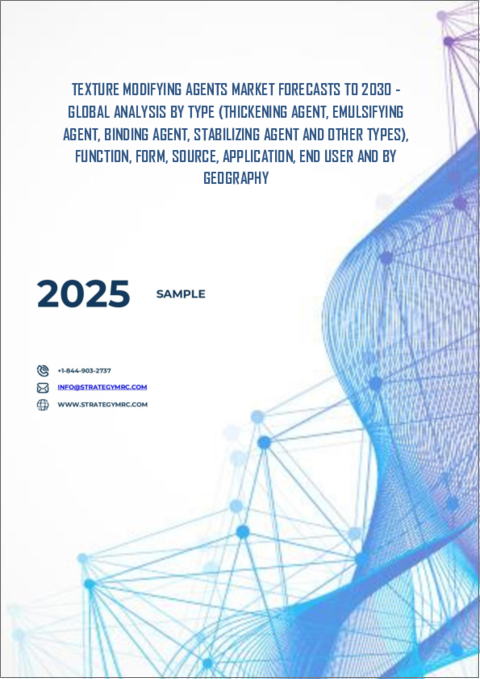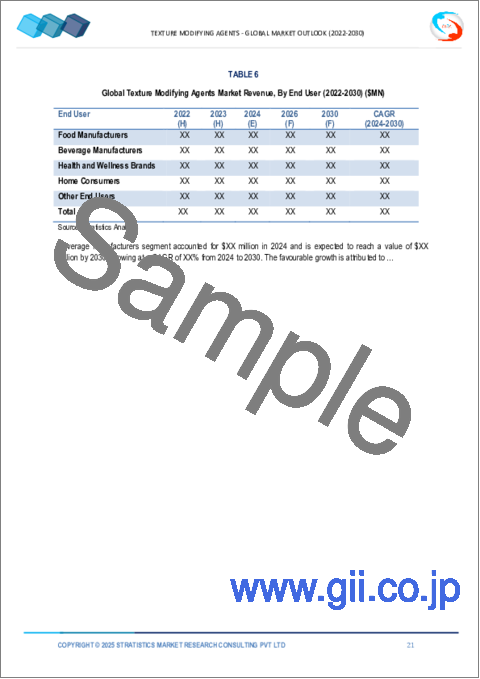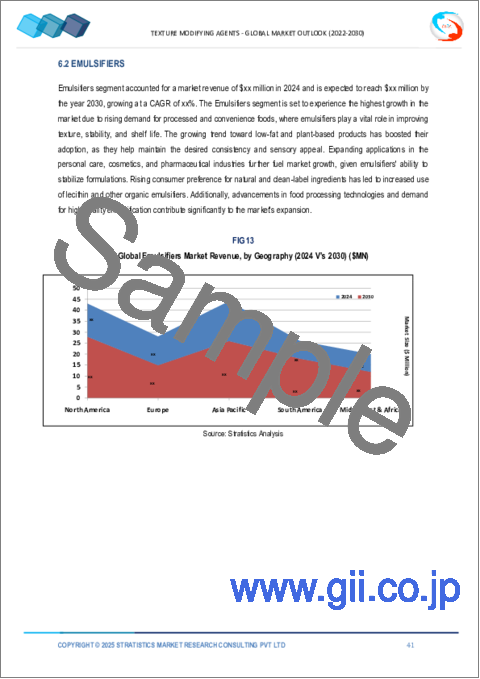|
|
市場調査レポート
商品コード
1603876
テクスチャー改良剤市場の2030年までの予測: タイプ別、機能別、形状別、供給源別、用途別、エンドユーザー別、地域別の世界分析Texture Modifying Agents Market Forecasts to 2030 - Global Analysis By Type (Thickening Agent, Emulsifying Agent, Binding Agent, Stabilizing Agent and Other Types), Function, Form, Source, Application, End User and By Geography |
||||||
カスタマイズ可能
|
|||||||
| テクスチャー改良剤市場の2030年までの予測: タイプ別、機能別、形状別、供給源別、用途別、エンドユーザー別、地域別の世界分析 |
|
出版日: 2024年11月11日
発行: Stratistics Market Research Consulting
ページ情報: 英文 200+ Pages
納期: 2~3営業日
|
全表示
- 概要
- 図表
- 目次
Stratistics MRCによると、テクスチャー改良剤の世界市場は2024年に153億米ドルを占め、予測期間中にCAGR 8.5%で成長し、2030年には249億米ドルに達する見込みです。
テクスチャー改良剤とは、食品、化粧品、医薬品において、製品の一貫性、感触、外観を変えるために使用される物質です。食品では、これらの製品は食感の改良に役立ち、ソース、スープ、アイスクリームなどの製品をより滑らかに、より濃厚に、より安定したものにします。一般的な例としては、ガム、でんぷん、乳化剤などがあります。化粧品では、クリーム、ローション、ジェルの官能特性を調整し、のび、とろみ、全体的な使用感を向上させるために使用されます。
コンビニエンス・フードへの需要の高まり
コンビニエンス・フードに対する需要の高まりが市場の成長を後押ししています。消費者は、官能的品質が改善された、すぐに食べられる手軽な食事を求めているため、メーカーはこれらの製品を使って食感、安定性、口当たりを向上させています。ガム、澱粉、乳化剤のような成分は、スナック、調理済み食品、飲料などの製品で望ましい一貫性を達成するのに役立ちます。便利な食品へのシフトは、食品業界における効果的なテクスチャー改良ソリューションの革新と需要を促進しています。
厳しい規制の枠組みは、コンプライアンス・コストを増加させ、製品開発期間を延長することによって、市場に課題をもたらす可能性があります。メーカーは、新しい原材料の複雑な承認プロセスを通過し、厳格な表示と安全基準を遵守しなければならないです。こうした規制は技術革新を制限し、新製品の市場参入を遅らせ、生産コスト全体を上昇させる可能性があります。その結果、企業は収益性の低下や市場の成長鈍化に直面する可能性があります。
健康志向とクリーンラベルの動向
健康志向とクリーンラベルの動向は、市場を再形成しています。消費者は、人工的な添加物や保存料を含まない、ナチュラルでクリーンラベルの原料を求めるようになっています。その結果、植物由来、オーガニック、最小限の加工しか施されていないテクスチャー改良剤への需要が高まっています。メーカー各社は、グアーガム、キサンタンガム、ペクチンのような、健康や透明性を損なうことなく機能的な利点を提供する代替品を開発することで対応しており、より健康的でシンプルな成分リストへの嗜好に合致しています。
限られた原料の入手可能性
市場で入手可能な原材料が限られているため、生産が中断され、コストが上昇する可能性があります。テクスチャー改良剤の多くは、グアーガムやでんぷんなどの特定の天然資源に依存しており、これらはサプライチェーンの変動に左右されます。これらの原料の希少性は、価格の変動、不足、生産の遅れにつながる可能性があります。この課題により、メーカーは高価な代替品を求めざるを得なくなったり、消費者の需要を満たすことが困難になり、最終的に収益性に影響を及ぼす可能性があります。
COVID-19の影響:
COVID-19の大流行は、サプライ・チェーンの混乱、原材料不足、労働力の問題を引き起こし、市場を混乱させました。コンフォートフードや家庭料理への消費者行動のシフトに伴い、安定剤や乳化剤のような特定のテクスチャー剤への需要が増加しました。しかし、生産の遅れや物流の問題が市場の成長を妨げました。さらに、経済の不確実性と必需品への集中により、パンデミックの間、新しいテクスチャー改良ソリューションへの技術革新と投資が鈍化しました。
増粘剤セグメントは予測期間中最大になると予測される
増粘剤セグメントは予測期間中最大の市場シェアを占めると予測されます。キサンタンガム、グアーガム、デンプン誘導体などのこれらの薬剤は、粘度を高め、製品の一貫性を向上させる。食品業界では、ソース、ドレッシング、飲食品において望ましい食感を実現するのに役立ち、化粧品業界では、乳液やクリームの安定化に役立ちます。クリーンラベル製品や天然製品に対する需要の高まりが、市場の拡大をさらに後押ししています。
予測期間中、食肉・家禽セグメントが最も高いCAGRが見込まれる
食肉・鶏肉セグメントは、食感、保湿性、全体的な品質を向上させるためにこれらの薬剤を利用し、予測期間中に最も高いCAGRが見込まれます。リン酸塩、ハイドロコロイド、でんぷんなどの成分は、ジューシーさ、柔らかさ、口当たりを向上させるために一般的に使用されます。消費者の嗜好がより高品質で加工され、利便性を重視した食肉製品へとシフトするにつれ、食肉・鶏肉セクターにおける食感改良剤の需要は伸び続け、官能的魅力と保存性の両方を向上させています。
最大のシェアを占める地域:
北米地域は、加工食品、植物由来の代替食品への需要の高まりにより、予測期間中最大の市場シェアを占めると予測されます。ガム、澱粉、ハイドロコロイドなどのこれらの製品は、食品や飲食品の食感、安定性、口当たりを向上させるのに不可欠です。消費者がより健康的な天然成分をますます優先するようになるにつれて、製剤の革新と持続可能性への関心の高まりが市場を牽引し、食品、化粧品、医薬品の各分野で継続的な成長を促しています。
CAGRが最も高い地域:
アジア太平洋地域は、健康とウェルネスに対する意識の高まりにより、予測期間中に最も高い成長率を記録すると予想されます。同地域の食品加工セクターの急成長により、多様な消費者の嗜好や嗜好に対応するために食感改良成分の使用が必要となっています。この地域における食品加工セクターの急成長は、多様な消費者の嗜好に応えるために食感改良食品の使用を必要とします。
無料カスタマイズサービス:
本レポートをご購読のお客様には、以下の無料カスタマイズオプションのいずれかをご利用いただけます:
- 企業プロファイル
- 追加市場企業の包括的プロファイリング(3社まで)
- 主要企業のSWOT分析(3社まで)
- 地域セグメンテーション
- 顧客の関心に応じた主要国の市場推計・予測・CAGR(注:フィージビリティチェックによる)
- 競合ベンチマーキング
- 製品ポートフォリオ、地理的プレゼンス、戦略的提携に基づく主要企業のベンチマーキング
目次
第1章 エグゼクティブサマリー
第2章 序文
- 概要
- ステークホルダー
- 調査範囲
- 調査手法
- データマイニング
- データ分析
- データ検証
- 調査アプローチ
- 調査情報源
- 1次調査情報源
- 2次調査情報源
- 前提条件
第3章 市場動向分析
- 促進要因
- 抑制要因
- 機会
- 脅威
- 用途分析
- エンドユーザー分析
- 新興市場
- COVID-19の影響
第4章 ポーターのファイブフォース分析
- 供給企業の交渉力
- 買い手の交渉力
- 代替品の脅威
- 新規参入業者の脅威
- 競争企業間の敵対関係
第5章 世界のテクスチャー改良剤市場:タイプ別
- 増粘剤
- 乳化剤
- 結合剤
- 安定剤
- その他のタイプ
第6章 世界のテクスチャー改良剤市場:機能別
- 乳化剤
- 安定剤
- ガム
- 増粘剤
- ハイドロコロイド
- ゼラチン
- 脂肪代替品
第7章 世界のテクスチャー改良剤市場:形状別
- 粉末
- 液体
- 顆粒
第8章 世界のテクスチャー改良剤市場:供給源別
- 自然
- 合成
- ハイブリッド
第9章 世界のテクスチャー改良剤市場:用途別
- 肉類および鶏肉
- 冷凍食品
- 調理済み食品とスナック
- 健康食品
- パン・菓子類
- その他の用途
第10章 世界のテクスチャー改良剤市場:エンドユーザー別
- 食品メーカー
- 飲料メーカー
- 健康とウェルネスブランド
- 家庭消費者
- その他のエンドユーザー
第11章 世界のテクスチャー改良剤市場:地域別
- 北米
- 米国
- カナダ
- メキシコ
- 欧州
- ドイツ
- 英国
- イタリア
- フランス
- スペイン
- その他欧州
- アジア太平洋
- 日本
- 中国
- インド
- オーストラリア
- ニュージーランド
- 韓国
- その他アジア太平洋地域
- 南米
- アルゼンチン
- ブラジル
- チリ
- その他南米
- 中東・アフリカ
- サウジアラビア
- アラブ首長国連邦
- カタール
- 南アフリカ
- その他中東とアフリカ
第12章 主な発展
- 契約、パートナーシップ、コラボレーション、合弁事業
- 買収と合併
- 新製品発売
- 事業拡大
- その他の主要戦略
第13章 企業プロファイリング
- Dow Inc.
- Ingredion Incorporated
- Cargill, Incorporated
- Tate & Lyle PLC
- BASF SE
- Kerry Group
- FMC Corporation
- ADM
- Lonza Group
- Royal DSM
- Ashland Global Holdings Inc.
- Wacker Chemie AG
- Solvay S.A.
- Evonik Industries AG
- Saputo Inc.
List of Tables
- Table 1 Global Texture Modifying Agents Market Outlook, By Region (2022-2030) ($MN)
- Table 2 Global Texture Modifying Agents Market Outlook, By Type (2022-2030) ($MN)
- Table 3 Global Texture Modifying Agents Market Outlook, By Thickening Agent (2022-2030) ($MN)
- Table 4 Global Texture Modifying Agents Market Outlook, By Emulsifying Agent (2022-2030) ($MN)
- Table 5 Global Texture Modifying Agents Market Outlook, By Binding Agent (2022-2030) ($MN)
- Table 6 Global Texture Modifying Agents Market Outlook, By Stabilizing Agent (2022-2030) ($MN)
- Table 7 Global Texture Modifying Agents Market Outlook, By Other Types (2022-2030) ($MN)
- Table 8 Global Texture Modifying Agents Market Outlook, By Function (2022-2030) ($MN)
- Table 9 Global Texture Modifying Agents Market Outlook, By Emulsifiers (2022-2030) ($MN)
- Table 10 Global Texture Modifying Agents Market Outlook, By Stabilizers (2022-2030) ($MN)
- Table 11 Global Texture Modifying Agents Market Outlook, By Gums (2022-2030) ($MN)
- Table 12 Global Texture Modifying Agents Market Outlook, By Thickeners (2022-2030) ($MN)
- Table 13 Global Texture Modifying Agents Market Outlook, By Hydrocolloids (2022-2030) ($MN)
- Table 14 Global Texture Modifying Agents Market Outlook, By Gelatin (2022-2030) ($MN)
- Table 15 Global Texture Modifying Agents Market Outlook, By Fat Replacers (2022-2030) ($MN)
- Table 16 Global Texture Modifying Agents Market Outlook, By Form (2022-2030) ($MN)
- Table 17 Global Texture Modifying Agents Market Outlook, By Powdered (2022-2030) ($MN)
- Table 18 Global Texture Modifying Agents Market Outlook, By Liquid (2022-2030) ($MN)
- Table 19 Global Texture Modifying Agents Market Outlook, By Granules (2022-2030) ($MN)
- Table 20 Global Texture Modifying Agents Market Outlook, By Source (2022-2030) ($MN)
- Table 21 Global Texture Modifying Agents Market Outlook, By Natural (2022-2030) ($MN)
- Table 22 Global Texture Modifying Agents Market Outlook, By Synthetic (2022-2030) ($MN)
- Table 23 Global Texture Modifying Agents Market Outlook, By Hybrid (2022-2030) ($MN)
- Table 24 Global Texture Modifying Agents Market Outlook, By Application (2022-2030) ($MN)
- Table 25 Global Texture Modifying Agents Market Outlook, By Meat and Poultry (2022-2030) ($MN)
- Table 26 Global Texture Modifying Agents Market Outlook, By Frozen Foods (2022-2030) ($MN)
- Table 27 Global Texture Modifying Agents Market Outlook, By Prepared Foods and Snacks (2022-2030) ($MN)
- Table 28 Global Texture Modifying Agents Market Outlook, By Health and Wellness Foods (2022-2030) ($MN)
- Table 29 Global Texture Modifying Agents Market Outlook, By Bakery and Confectionery (2022-2030) ($MN)
- Table 30 Global Texture Modifying Agents Market Outlook, By Other Applications (2022-2030) ($MN)
- Table 31 Global Texture Modifying Agents Market Outlook, By End User (2022-2030) ($MN)
- Table 32 Global Texture Modifying Agents Market Outlook, By Food Manufacturers (2022-2030) ($MN)
- Table 33 Global Texture Modifying Agents Market Outlook, By Beverage Manufacturers (2022-2030) ($MN)
- Table 34 Global Texture Modifying Agents Market Outlook, By Health and Wellness Brands (2022-2030) ($MN)
- Table 35 Global Texture Modifying Agents Market Outlook, By Home Consumers (2022-2030) ($MN)
- Table 36 Global Texture Modifying Agents Market Outlook, By Other End Users (2022-2030) ($MN)
Note: Tables for North America, Europe, APAC, South America, and Middle East & Africa Regions are also represented in the same manner as above.
According to Stratistics MRC, the Global Texture Modifying Agents Market is accounted for $15.3 billion in 2024 and is expected to reach $24.9 billion by 2030 growing at a CAGR of 8.5% during the forecast period. Texture modifying agents are substances used in food, cosmetics, and pharmaceuticals to alter the consistency, feel, or appearance of a product. In food, these agents help modify the texture, making products smoother, thicker, or more stable, such as in sauces, soups, and ice cream. Common examples include gums, starches, and emulsifiers. In cosmetics, they are used to adjust the sensory properties of creams, lotions, and gels, enhancing spreadability, thickness, and overall user experience.
Market Dynamics:
Driver:
Rising demand for convenience foods
The rising demand for convenience foods is driving growth in the market. As consumers seek quick, ready-to-eat meals with improved sensory qualities, manufacturers use these agents to enhance texture, stability, and mouthfeel. Ingredients like gums, starches, and emulsifiers help achieve the desired consistency in products such as snacks, ready meals, and beverages. This shift towards convenience foods is fueling innovation and demand for effective texture-modifying solutions in the food industry.
Restraint:
Stringent regulatory frameworks can pose challenges in the market by increasing compliance costs and extending product development timelines. Manufacturers must navigate complex approval processes for new ingredients and adhere to strict labeling and safety standards. These regulations may limit innovation, delay market entry of new products, and increase the overall cost of production. As a result, companies may face reduced profitability and slower growth in the market.
Opportunity:
Health consciousness and clean label trends
Health consciousness and clean label trends are reshaping the market. Consumers increasingly seek natural, clean-label ingredients free from artificial additives and preservatives. As a result, there is a growing demand for plant-based, organic, and minimally processed texture-modifying agents. Manufacturers are responding by developing alternatives like guar gum, xanthan gum, and pectin, which provide functional benefits without compromising on health or transparency, aligning with the preference for healthier, simpler ingredient lists.
Threat:
Limited raw material availability
Limited raw material availability in the market can disrupt production and inflate costs. Many texture-modifying agents rely on specific natural resources, such as guar gum or starches, which are subject to supply chain fluctuations. Scarcity of these raw materials can lead to price volatility, shortages, and production delays. This challenge may force manufacturers to seek expensive alternatives or face difficulties in meeting consumer demand, ultimately affecting profitability.
Covid-19 Impact:
The COVID-19 pandemic disrupted the market by causing supply chain disruptions, raw material shortages, and labor challenges. With shifts in consumer behavior towards comfort foods and home cooking, demand for certain texture agents like stabilizers and emulsifiers increased. However, production delays and logistical issues hindered market growth. Additionally, economic uncertainty and focus on essential goods led to slower innovation and investment in new texture-modifying solutions during the pandemic.
The thickening agent segment is projected to be the largest during the forecast period
The thickening agent segment is projected to account for the largest market share during the projection period. These agents, such as xanthan gum, guar gum, and starch derivatives, enhance viscosity and improve product consistency. In the food industry, they aid in achieving desired textures in sauces, dressings, and beverages, while in cosmetics, they help in stabilizing emulsions and creams. The growing demand for clean-label and natural products further drives the market's expansion.
The meat & poultry Segment is expected to have the highest CAGR during the forecast period
The meat & poultry segment is expected to have the highest CAGR during the extrapolated period utilizing these agents to improve texture, moisture retention, and overall quality.. Ingredients like phosphates, hydrocolloids, and starches are commonly used to enhance juiciness, tenderness, and mouthfeel. As consumer preferences shift toward higher-quality, processed, and convenience-driven meat products, the demand for texture-modifying agents in the meat and poultry sector continues to grow, improving both sensory appeal and shelf life.
Region with largest share:
North America region is projected to account for the largest market share during the forecast period due to rising demand for processed foods, plant-based alternatives. These agents, such as gums, starches, and hydrocolloids, are essential in enhancing the texture, stability, and mouthfeel of food and beverages. As consumers increasingly prioritize healthier, natural ingredients, the market is driven by innovation in formulation and the growing focus on sustainability, fueling continued growth across food, cosmetics, and pharmaceuticals sectors.
Region with highest CAGR:
Asia Pacific is expected to register the highest growth rate over the forecast period driven by increasing awareness about health and wellness. The rapid growth of the food processing sector in the region necessitates the use of texture-modifying ingredients to cater to diverse consumer tastes and preferences. The rapid growth of the food processing sector in the region necessitates the use of texture-modifying ingredients to cater to diverse consumer tastes and preferences.
Key players in the market
Some of the key players in Texture Modifying Agents market include Dow Inc., Ingredion Incorporated, Cargill, Incorporated, Tate & Lyle PLC, BASF SE, Kerry Group, FMC Corporation, ADM, Lonza Group, Royal DSM, Ashland Global Holdings Inc., Wacker Chemie AG, Solvay S.A., Evonik Industries AG and Saputo Inc.
Key Developments:
In November 2024, BASF announced that it will invest in additional production capacity for its X3D(R) technology, a new additive manufacturing technology for catalysts based on 3D printing. The plant will produce catalysts on an industrial scale and is expected to be operational in 2026.
In November 2024, Kerry Group acquired DirectSens' LactoSens technology, a lactose detection test for dairy products. The taste and nutrition giant said the LactoSens platform is used by food and beverage companies to check for the sugar naturally found in dairy products.
Types Covered:
- Thickening Agent
- Emulsifying Agent
- Binding Agent
- Stabilizing Agent
- Other Types
Functions Covered:
- Emulsifiers
- Stabilizers
- Gums
- Thickeners
- Hydrocolloids
- Gelatin
- Fat Replacers
Forms Covered:
- Powdered
- Liquid
- Granules
Sources Covered:
- Natural
- Synthetic
- Hybrid
Applications Covered:
- Meat and Poultry
- Frozen Foods
- Prepared Foods and Snacks
- Health and Wellness Foods
- Bakery and Confectionery
- Other Applications
End Users Covered:
- Food Manufacturers
- Beverage Manufacturers
- Health and Wellness Brands
- Home Consumers
- Other End Users
Regions Covered:
- North America
- US
- Canada
- Mexico
- Europe
- Germany
- UK
- Italy
- France
- Spain
- Rest of Europe
- Asia Pacific
- Japan
- China
- India
- Australia
- New Zealand
- South Korea
- Rest of Asia Pacific
- South America
- Argentina
- Brazil
- Chile
- Rest of South America
- Middle East & Africa
- Saudi Arabia
- UAE
- Qatar
- South Africa
- Rest of Middle East & Africa
What our report offers:
- Market share assessments for the regional and country-level segments
- Strategic recommendations for the new entrants
- Covers Market data for the years 2022, 2023, 2024, 2026, and 2030
- Market Trends (Drivers, Constraints, Opportunities, Threats, Challenges, Investment Opportunities, and recommendations)
- Strategic recommendations in key business segments based on the market estimations
- Competitive landscaping mapping the key common trends
- Company profiling with detailed strategies, financials, and recent developments
- Supply chain trends mapping the latest technological advancements
Free Customization Offerings:
All the customers of this report will be entitled to receive one of the following free customization options:
- Company Profiling
- Comprehensive profiling of additional market players (up to 3)
- SWOT Analysis of key players (up to 3)
- Regional Segmentation
- Market estimations, Forecasts and CAGR of any prominent country as per the client's interest (Note: Depends on feasibility check)
- Competitive Benchmarking
- Benchmarking of key players based on product portfolio, geographical presence, and strategic alliances
Table of Contents
1 Executive Summary
2 Preface
- 2.1 Abstract
- 2.2 Stake Holders
- 2.3 Research Scope
- 2.4 Research Methodology
- 2.4.1 Data Mining
- 2.4.2 Data Analysis
- 2.4.3 Data Validation
- 2.4.4 Research Approach
- 2.5 Research Sources
- 2.5.1 Primary Research Sources
- 2.5.2 Secondary Research Sources
- 2.5.3 Assumptions
3 Market Trend Analysis
- 3.1 Introduction
- 3.2 Drivers
- 3.3 Restraints
- 3.4 Opportunities
- 3.5 Threats
- 3.6 Application Analysis
- 3.7 End User Analysis
- 3.8 Emerging Markets
- 3.9 Impact of Covid-19
4 Porters Five Force Analysis
- 4.1 Bargaining power of suppliers
- 4.2 Bargaining power of buyers
- 4.3 Threat of substitutes
- 4.4 Threat of new entrants
- 4.5 Competitive rivalry
5 Global Texture Modifying Agents Market, By Type
- 5.1 Introduction
- 5.2 Thickening Agent
- 5.3 Emulsifying Agent
- 5.4 Binding Agent
- 5.5 Stabilizing Agent
- 5.6 Other Types
6 Global Texture Modifying Agents Market, By Function
- 6.1 Introduction
- 6.2 Emulsifiers
- 6.3 Stabilizers
- 6.4 Gums
- 6.5 Thickeners
- 6.6 Hydrocolloids
- 6.7 Gelatin
- 6.8 Fat Replacers
7 Global Texture Modifying Agents Market, By Form
- 7.1 Introduction
- 7.2 Powdered
- 7.3 Liquid
- 7.4 Granules
8 Global Texture Modifying Agents Market, By Source
- 8.1 Introduction
- 8.2 Natural
- 8.3 Synthetic
- 8.4 Hybrid
9 Global Texture Modifying Agents Market, By Application
- 9.1 Introduction
- 9.2 Meat and Poultry
- 9.3 Frozen Foods
- 9.4 Prepared Foods and Snacks
- 9.5 Health and Wellness Foods
- 9.6 Bakery and Confectionery
- 9.7 Other Applications
10 Global Texture Modifying Agents Market, By End User
- 10.1 Introduction
- 10.2 Food Manufacturers
- 10.3 Beverage Manufacturers
- 10.4 Health and Wellness Brands
- 10.5 Home Consumers
- 10.6 Other End Users
11 Global Texture Modifying Agents Market, By Geography
- 11.1 Introduction
- 11.2 North America
- 11.2.1 US
- 11.2.2 Canada
- 11.2.3 Mexico
- 11.3 Europe
- 11.3.1 Germany
- 11.3.2 UK
- 11.3.3 Italy
- 11.3.4 France
- 11.3.5 Spain
- 11.3.6 Rest of Europe
- 11.4 Asia Pacific
- 11.4.1 Japan
- 11.4.2 China
- 11.4.3 India
- 11.4.4 Australia
- 11.4.5 New Zealand
- 11.4.6 South Korea
- 11.4.7 Rest of Asia Pacific
- 11.5 South America
- 11.5.1 Argentina
- 11.5.2 Brazil
- 11.5.3 Chile
- 11.5.4 Rest of South America
- 11.6 Middle East & Africa
- 11.6.1 Saudi Arabia
- 11.6.2 UAE
- 11.6.3 Qatar
- 11.6.4 South Africa
- 11.6.5 Rest of Middle East & Africa
12 Key Developments
- 12.1 Agreements, Partnerships, Collaborations and Joint Ventures
- 12.2 Acquisitions & Mergers
- 12.3 New Product Launch
- 12.4 Expansions
- 12.5 Other Key Strategies
13 Company Profiling
- 13.1 Dow Inc.
- 13.2 Ingredion Incorporated
- 13.3 Cargill, Incorporated
- 13.4 Tate & Lyle PLC
- 13.5 BASF SE
- 13.6 Kerry Group
- 13.7 FMC Corporation
- 13.8 ADM
- 13.9 Lonza Group
- 13.10 Royal DSM
- 13.11 Ashland Global Holdings Inc.
- 13.12 Wacker Chemie AG
- 13.13 Solvay S.A.
- 13.14 Evonik Industries AG
- 13.15 Saputo Inc.






